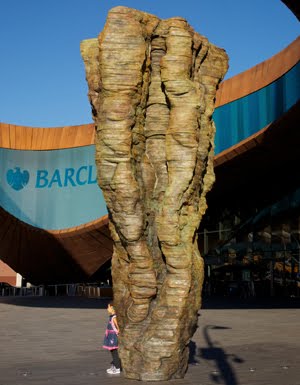 |
| Ursula in 2013, age 71 |
 |
| Ursula's studio in 2011 |
 |
 |
| Ursula and Paul |
She was born in Germany, but she spent her career in Brooklyn, New York.
Background: Ursula Karoliszyn was born in Germany to Polish parents, one of seven children. After several years in refugee camps, Ursula's family were able to leave Germany. In 1950, when Ursula was 8, they came to the U.S. and settled in Plainville, Connecticut, where her father worked in a tool-making factory.
Ursula says that while she doesn't think about the refugee camps while she works, she feels the influence of her time among the Polish peasants, and feels that working with wood is something her ancestors did for generations.
Training: Ursula studied art at the University of New Hampshire, and earned an MFA from the Columbia's Graduate School of the Arts in New York City in 1975.
Private life: Ursula met her first husband, Milton von Rydingsvard, while she was at the university. He was a premed student, and she followed him to Berkeley, CA, and Coral Gables, Florida, while he continued his medical studies. They had one daughter, Ursula Anne.
In 1985, when she was 43, Ursula married Paul Greengard, a neuroscientist and Nobel Prize winner.
Career: Ursula started her career in the 1970s when a type of art known as Minimalism dominated the world of sculpture. Pioneered by artists like Dan Flavin and Donald Judd, minimalists favored sparse, elemental forms, lacking in emotion, sexuality, and vulnerability. Here are examples of their work.
Examples of Minimalist Sculpture
 |
| Donald Judd, 1928-1994 Untitled, 1966 Whitney / Jan's photo, 2015 |
 |
| Dan Flavin Untitled (in honor of Leo at the 30th anniversary of his gallery), 1987 SFMOMA / Internet |
Ursula started out working with welded steel, in the direction of minimalism, but steel felt sterile to her. During her final year at Columbia she discovered red cedar planks. Red cedar is soft and aromatic, and for Ursula it was a way to oppose Minimalism with work that feels sensuous and emotive.
Ursula has milled cedar planks trucked from a saw mill on Vancouver Island in British Columbia to her huge warehouse in Brooklyn where she and her assistants laminate them into stacks and then use circular saws and chisels to further shape the form and add texture to the surface.
She uses the stacks of planks as a blank canvas that allows her to express a range of feelings and ideas. Though her shapes are abstract, they refer to natural phenomena.
Cedar is a fragrant wood that can cause allergies. Over the years, Ursula has become allergic to cedar dust and must wear a 15-pound suit with air pumped into it while she is working. Recently one of her works had to be removed from the lobby of a federal building because some employees reported serious allergic reactions.
In recent years, she has had some of her works translated into bronze from full-size cedar maquettes. She has also done some pieces in cast resin.
Ursula's career took off in the mid-1970s when she started exhibiting her new cedar works, and she quickly became successful. Her monumental outdoor works are favorites with American museums. She also does smaller pieces to hang on interior walls.
My photos of Ursula's Work:
 |
| Three Bowls, 1990 Nelson-Atkins / Jan's photo, 2013 |
 |
| Doolin, Doolin, 1997 University of Wyoming / Jan's photo, 2010 |
 |
| Czara z Babelkami, 2006 SFMOMA / Jan's photo, 2015 |
 | ||
| Ogromna, 2009 North Carolina / Jan's photo, 2010 |
 |
| Bent Lace, 2014 bronze MOMA / Jan's photo 2015 |
Internet Examples
The sculpture below is installed in front of Barclays Center, an arena for sports and entertainment in Brooklyn.
 |
| Ona, 2013 Bronze, 19 ' tall Internet |
The sculpture below is electrified and illuminated from the interior, causing it to glow at night.
 |
| Elegantka, 2010 Cast resin de Cordova Sculpture Park, Lincoln, MA / Internet |
 |
| Cedrus, 2015 Lobby of FBI office in Miami |

